A few months ago, when I first saw the Polyraptor/Forerunner of the Empire combo from Rivals of Ixalan, my first thought was “oh, cute, eight dinosaurs”. My second one was “wait… if you can hit Forerunner of the Empire with Appeal//Authority, you get 256 Polyraptors. And if you can do it again, you get 2^256 Polyraptors!”
I was inspired.
I’ve always been fascinated with the “most damage dealt on turn 1 without infinite combos” article that’s been floating around reddit for a while, and something about the interaction of Appeal and Polyraptor reminded me of the strategies that deck used to generate its absurd damage total. It got me thinking, could we do the same thing in standard?
After that, one thing led to another, multiple months went by, and it turns out the answer is “yes”. I give you a standard-legal decklist that, without any infinite combos, deals more damage in a single turn than any other deck I know of. Fair warning, this will involve math.
The original challenge, for anyone who hasn’t seen it, is to find a vintage-legal deck of 60 cards that, on turn 1 against a goldfish, deals the most damage possible, without using any infinite combos. Going infinite is cheating. To help you out, the deck operates in magical Christmasland: you will always draw the exact card you want, every time. You can see a writeup of their list here. Turn one in standard is uninteresting, so I’ve relaxed that requirement: instead, the goal is to just do it as quickly as possible, with the understanding that dealing lots of damage gets less impressive the more time you have to set up. All the other rules still apply.
I’ve left the decklist printed out here, organized by the role the card plays in the deck. By all means, try it out, though I wouldn’t advise it: Only six lands, none of which can produce black, white or red despite the deck’s playing 11 cards in Mardu colors, 11 6+ drops, it’s a real mess. Outside of the specific rules of this challenge, there are trillion-to-one odds that this deck will get anything done at all.
And yet, its god draw deals more damage than any other deck I’ve been able to create. It deals more damage than there are atoms in the universe. It deals more damage than there are possible games of chess to be played. And it does so without access to any infinite combos.
In standard.
With dinosaurs.
Setup:
3x Ipnu Rivulet
1x Shore Keeper
2x Forest
1x Growing Rites of Itlimoc
2x Ornithopter
4x Vizier of Tumbling Sands
1x Tishana, Voice of Thunder
1x Evolving Wilds
1x Rashmi, Eternities Crafter
1x Sacred Excavation
1x Nissa, Genesis Mage
1x Ghirapur Orrery
1x Champion of Wits
Engine:
1x Forerunner of the Empire
1x Polyraptor
4x Swarm Intelligence
1x Anointed Procession
1x Failure//Comply
1x Cogwork Assembler
1x Panharmonicon
1x Arcane Adaptation
1x Cherished Hatchling
4x Aid from the Cowl
Layers:
1x Spontaneous Artist
1x Wildfire Eternal
1x Appeal//Authority
1x Insidious Will
1x Torrential Gearhulk
1x Merciless Javelineer
1x Hope Tender
1x Select for Inspection
1x Aetherwind Basker
1x Storm Sculptor
1x Sunscourge Champion
1x Run Aground
1x Gishath, Sun’s Avatar
1x Dive Down
1x Combat Celebrant
1x Hostage Taker
1x Baffling End
1x Ajani Unyielding
1x Naturalize
5x other irrelevant cards (let’s say, a playset of Yargle and a Voltaic Servant)
The core interaction of this deck isn’t actually Polyraptor/Forerunner at all: it’s Cogwork Assembler and Panharmonicon. By feeding all our mana into Cogwork Assembler’s ability to make more and more token copies of Panharmonicon, we can make every single enters-the-battlefield ability on our creatures trigger not just once, but as many times as we have mana to pay for it beforehand. All we have to do is to make sure that the amount of mana we can feed into the Assembler is “a lot”, and that’s what the other 58 cards, including Polyraptor and Forerunner, are for.
Section 0: Setting up over Turns 1-5
We start out pretty innocuously: On turn 1, we play an Ipnu Rivulet and pay a life to play Shore Keeper.
Turn 2 stays almost normal. We play a Forest and a Hope Tender, and pass.
On turn 3, we start to get a bit more spicy. We play a second Ipnu Rivulet, and tap out to play Growing Rites of Itlimoc, revealing an Ornithopter. After that, we play two Ornithopters, and pass without attacking. Growing Rites of Itlimoc transforms into Itlimoc, Cradle of the Sun on our end step. We have 2 cards in hand.
The next few turns will each be a combo to themselves. We go off and make all our Polyraptors on turn 6. On turn 5, we will play all the assorted cards we need to play in order to get our main combo going. On turn 4, we will play all the cards we need to in order to get the resources we need for turn 5.
We start by tapping Itlimoc and forest for 5 and spending 1 to exert Hope Tender, untapping both. We spend 3 of the remaining 4 to play Cogwork Assembler. We tap Itlimoc again, this time for 5 (6 total floating), and spend 4 of that and a blue from Rivulet 1 (18 life) to play Rashmi, Eternities Crafter. Spend the last card in our hand and GU (17 life) to cycle a Vizier of Tumbling Sands, untapping Hope Tender and drawing a card: a second Vizier of Tumbling Sands. Exert Hope Tender (0 green floating) to untap Rivulet and Itlimoc, and tap both, going down to 16 life and up to 6 G and a U. Note that as long as we keep drawing Viziers, we can keep spending 1 life and GGU to cycle them, drawing a new card and adding a net of 4 more green mana to our mana pool. Do so 3 more times, leaving us fresh out of Viziers, at which point we will be at 13 life, with 1 U and 18 G in the pool. Spend 6 G and U of that to play our last card: Tishana, Voice of Thunder. She immediately dies, but we still get her trigger, drawing another 6 cards. We still have 12 mana in the pool.
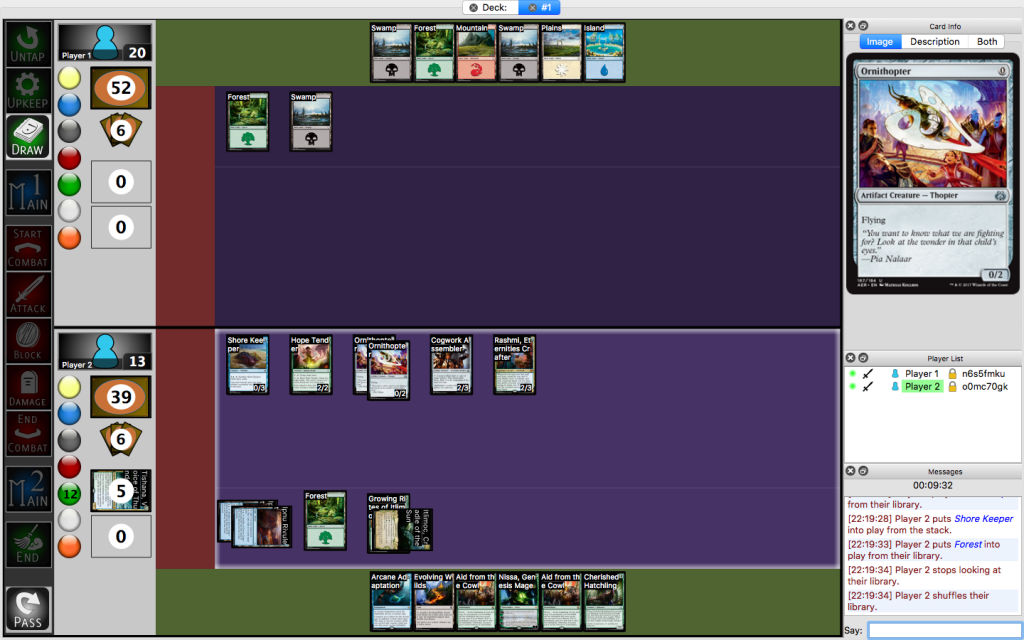
Spend all of it to play Cherished Hatchling and a pair of Aid from the Cowls, and finally play our land for the turn: Evolving Wilds, which we immediately sacrifice to find a forest. We pass the turn, and both Aid from the Cowls trigger, revealing Anointed Procession and Gishath, Sun’s Avatar. We put both on the battlefield, and move on to turn 5.
Turn 5:
We draw our card for the turn, giving us 3 cards in hand, all unknown. We start off by tapping Itlimoc, this time for 8 (since the last time we checked, we’ve gotten out both Gishath and Cherished Hatchling). We spend 7 of that playing Nissa, Genesis Mage. Rashmi triggers, and we reveal and cast Panharmonicon. We activate Nissa’s +2, untapping Itlimoc and Hope Tender. We tap Itlimoc again, and go up to 9 mana. We spend 7 of that and a U (down to 12 life) to activate Shore Keeper (from turn 1, remember?), sacrificing it to draw 3 cards. We go down to 11 life and tap our second Ipnu Rivulet to play Arcane Adaptation, naming Dinosaur. With that done, we move to combat.
We only attack with Gishath: we don’t want to deal the goldfish any more damage than we have to. They have no blocks, and take the full 7, causing Gishath to trigger and us to reveal the top 7 cards of our library. All our creatures are dinosaurs thanks to Arcane Adaptation, so any creatures we can cast with this are good hits.
And because this is magical christmasland, we reveal Combat Celebrant, Wildfire Eternal, Spontaneous Artist, Forerunner of the Empire, Merciless Javelineer, Champion of Wits, and Torrential Gearhulk. Thanks to Panharmonicon, we get 14 damage triggers from Forerunner, none of which we use, 2 energy from Spontaneous Artist, and four loots off Champion of Wits, which we just use to mill four instants into our graveyard: Select for Inspection, Failure//Comply, Run Aground, and Insidious Will.
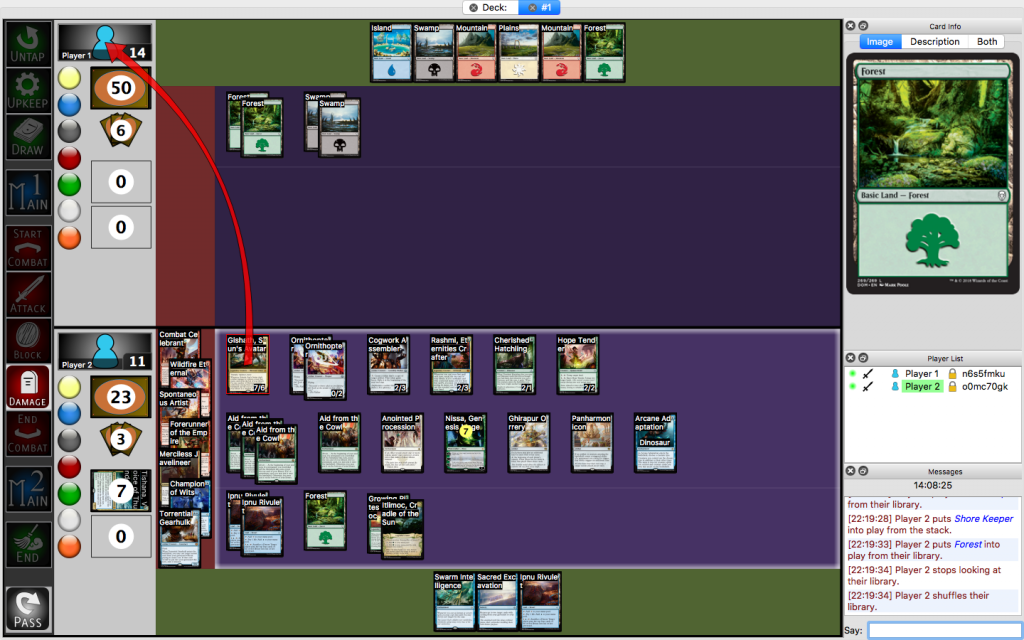
By the way, if you read that paragraph and went “oh come on, you’re cheating out Gearhulks with Gishath, that’s absurd!”, well… I’d stop reading now. It’s only getting worse.
After that, we play our land for the turn, a third Ipnu Rivulet, and tap a Forest to exert Hope Tender, untapping another Rivulet and Itlimoc. We tap Itlimoc for 14 green mana, tap a Rivulet for U (10 life) and play Sacred Excavation (11 G floating), getting back two Viziers. We use the same pattern of spending GGU to get a free untap of one of our lands, but since Itlimoc now taps for 14 and we need blue mana more than we need green, we only target Itlimoc with it once, which is enough to get us to 23 G floating. The second time, we go down to 21 G and 7 life to get 2 untaps of Rivulet, leaving us with 21 G and U in our pool, and an untapped Rivulet. We don’t really need it.
We have 4 cards left in our hand: Swarm Intelligence, Ghirapur Orrery, and the rest of our Aid from the Cowls. We play all of them, leaving behind exactly G in our pool. We let it drain, and pass the turn. Because we sacrificed Tide Keeper a while back, all our Aid from the Cowls trigger, and we reveal: Ajani Unyielding, Baffling End (which does nothing, since our opponent has no creatures), and two more Swarm Intelligences. All our pieces are in order.
Turn 6:
Now would be a good time to buckle your seatbelt.
Section 1: Green Mana



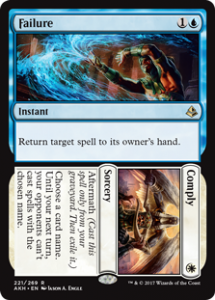
We start off by drawing 3 cards of Ghirapur Orrery. After our draw step, we wind up with 4 cards, which must be:
Aetherwind Basker
Appeal
Polyraptor
Storm Sculptor

We start, as usual, by tapping Itlimoc (for 14 again) and activate Nissa’s +2 again, untapping Hope Tender and Itlimoc. Then, finally, we play Polyraptor. This triggers Rashmi, and we reveal one more card from our library: the fourth Swarm Intelligence, which we immediately cast. Polyraptor enters the battlefield and triggers Forerunner of the Empire, which we decline to use, because it would kill Combat Celebrant and that would be a Very Bad Thing.
Note: Unfortunately, Polyraptor isn’t indestructible, so some number of them will die each time you do your damage. The way we account for this is, rather than try to factor them in, we just assume any damaged Polyraptors immediately die. Because of Anointed Procession, this rounding down means that each time we deal a damage, we double our Polyraptor Count. That’s actually the only reason Anointed Procession is in the deck: making the math neater. That’s a /lot/ of rounding down, but don’t worry, the growth rate of our Polyraptor count is so high that we won’t notice.
Now, we tap Itlimoc again, for 15 mana (bringing us up to 20 in the pool), and spend 1 of that mana to cast Appeal. All of our Swarm Intelligences trigger, and we get four copies of Appeal, which we can target as we please. We can have them target any of our creatures, but we can’t let the original cast resolve: almost the entire rest of this combo will happen while that Appeal is still on the stack. As it is, let’s say the Appeal copies go on Combat Celebrant, Hope Tender, Forerunner of the Empire, and Cogwork Assembler.
Once the copies resolve, we spend another 7 mana to activate Cogwork Assembler, targeting Torrential Gearhulk. We create two token copies, and each one’s abilities trigger twice (thanks to Panharmonicon), but we only care about one of the triggers: we have it target Insidious Will. We cast Insidious Will for free, targeting Appeal. Swarm Intelligence triggers four times, and we get four copies of Appeal, which we use to pump Spontaneous Artist, Wildfire Eternal, Merciless Javelineer, and Gishath, Sun’s Avatar. We’re going to round down in the latter case and say that all of these creatures just got pumped by +14/+14.
We can’t let Insidious Will itself resolve, though. If we do, it’ll get exiled, and we have no way to get it back from there. Instead, we spend another 7 green mana to create another Torrential Gearhulk, this time having its ability target Failure//Comply. As usual, we get 4 Swarm Intelligence triggers, and we have the copies all target either Insidious Will or our own Failure//Comply, making sure at least one copy targets each. The copies resolve, and bounce both spells back to our hand, saving them from Torrential Gearhulk’s exile (which, if you read it closely, only works if the spell goes to the graveyard).
There is one other thing we get to do now: those Torrential Gearhulk tokens created a lot of Forerunner of the Empire triggers. We let one resolve, dealing 1 damage to everything. This causes 2 things to happen:
Cherished Hatchling takes 1 damage and dies, letting us cast Dinosaur spells as if they had flash. Since all our creatures are dinosaurs thanks to Arcane Adaptation, that means every creature spell we play can be played at instant speed this turn. That might be important later, I dunno.
Polyraptor gets dealt a damage and triggers enrage. It tries to create a token copy of itself, but Anointed Procession doubles it to 2 tokens. Then, because all our important creatures have more toughness to spare, we do it again, and our 2 dinosaurs become 4. We’ve pumped all of our critical creatures with Appeal except one: Gishath, which has 6 toughness, so we can afford to do this 5 total times, each time doubling our Polyraptor count until we end up with 32 5/5 dinos.
Not bad, not bad. It’s certainly a start.
At this point, we have a problem: Both of our critical spells are stuck in hand, and we can only cast them by either paying life we can’t afford or by copying Torrential Gearhulk. This is where Merciless Javelineer comes in. By paying 4 more generic, we can discard both of our instants to put 2 -1/-1 counters on a random creature (for best results, use a damaged Polyraptor), and we’re ready to go again!
There is a problem with this line. Next time, it won’t cost just 18 mana like it did just now. We cheated this time by using the copies from our original cast of Appeal, but we can’t keep doing that. In the future, each time we want to run through the forerunner loop, we’ll need to use Torrential to cast Insidious Will THREE times: We have nine creatures we have to pump each time, and we only get four copies of Appeal with each cast. Each Appeal cast costs 18 mana (7 to copy Torrential and cast Insidious Will, 7 to copy Torrential and cast Failure, and another 4 to discard both to the Javelineer), so it will cost 54 generic mana to go through this loop next time.
What do we get for that massive mana investment? Well, when our Appeal copies resolve, all our critical creatures (including Forerunner), wind up with X extra toughness, which is roughly equal to the number of Polyraptors we’ve created so far, or our Polyraptor Count. Right now, we also have a bunch of other creatures, but our Polyraptor count will soon get so much larger that a small factor like 8 more won’t change anything. Each point of toughness on our must-live creatures lets us double our Polyraptor count, so every 54 generic mana we spend will (roughly) turn X Polyraptors into 2^X Polyraptors.
Now, before letting Appeal resolve, we spend our last remaining green mana to activate Hope Tender, untapping Itlimoc and tapping it for some mana. This time, just this once, we’ll take into account the damaged Polyraptors, to get an exact number for the mana we generate.
We’ve dealt 5 damage to our creatures, which is enough for the first, nontoken Polyraptor to die, and no others. When the damaged ones are included, each point actually triples our count, until they start dying, at which point it gets too complicated to account for. As a result, we’ve created 3^5-1 Polyraptors, or 242. Include our 9 must-live creatures (everything else has died), and the 4 Torrential Gearhulk copies we’ve made (which are all 1 point of toughness from dying), and we have 255 creatures. Itlimoc taps for 255 mana. That’s enough to run through our 54-mana loop another 4 times. The first brings our Polyraptor count up from 242 to 2^242 (it’s already a challenging problem to account for the damaged Polyraptors, so we’re done with that). 2^242 is only 73 digits long, so here you go:
7,067,388,259,113,537,318,333,190,002,971,674,063,309,935,587,502,475,832,486,424,805,170,479,104 Polyraptors. Apparently that’s about 7 trevigintillion. Did you know that names for numbers go that high? I always figured they stopped around “septillion”.
Anyays, wave goodbye to that number, because that’s the last time we’ll be able to write out the entire Polyraptor count like that. Our second 54-mana investment takes us to 2^(2^242) Polyraptors, which is far too large to fit its digits onto every hard disk in existence combined, much less this blog post. Our third one takes us beyond even that, to 2^(2^(2^242)) creatures, and our last one adds another exponent to the end: 2^(2^(2^(2^242))).
Nesting powers like that will get real unwieldy real fast, so we’re going to switch to something called “Knuth up-arrow notation”. Basically, this mathematician Donald Knuth needed a way to describe Very Big Numbers that resulted from certain kinds of recursive functions (coincidentally, the same kind of functions we’re simulating to make all these Polyraptors), and came up with this: just like how A*B can be written as A+(A+(A+(…(A+A), with A repeated B times, A arrow B, or A^B, is A*(A*(A*(…(A*A), with A repeated B times. If you look closely, that’s the same as the definition for exponents. It gets more complicated when you add more arrows: A two-arrow B, or A^^B, is A arrow (A arrow (A arrow … (A arrow A), B times. This is exactly what we’re doing when we cast Appeal! If we round down that starting 242 to, say, 4, or 2^2, we can stop expressing our Polyraptor count as a giant chain of 2^(2^(2^(2^(…..) and express it much more neatly as 2^^X, where X is roughly the number of times we make that investment of 54 mana. In this case, we went through it 4 times, and our total at the end is 2^(2^(2^(2^(2^2)))), rounding 242 down to 2^2. That is exactly equal to 2^^6, which, if you’re curious, is a number so big that the number of digits in it is itself a 20,000 digit number. Isn’t that so much easier to wrap your brain around? No? Okay, well, just do your best, cause we’re just getting started.
We can even keep going. If we were to start adding pairs of arrows to the front, so it became 2^^(2^^6)), we could do the same thing: round down the last number to 4, and add an arrow. It would become 2^^(2^^(2^^2)), which is the same as 2^^^4. And so on, and so forth. Note that, no matter how many arrows are between them, 2^^…^^2 will always equal 4.
So there we are. We have 2^^6 Polyraptors, and we’re down to only 39 green mana in our pool: not enough to keep going.
If only we had a way to generate more…
Input: 54 generic mana
Output: lots of copies of Polyraptor
Layer count: 1 (don’t worry, you’ll get it).
Section 2: Energy
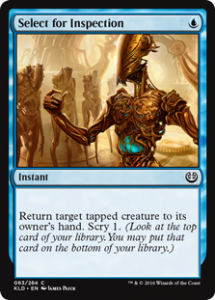
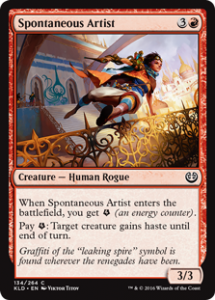
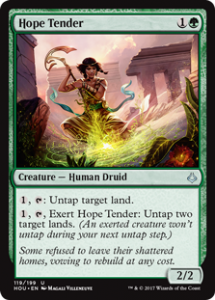

We’ve already shown that we can generate a whole lot of mana by tapping and untapping Itlimoc using Hope Tender. The problem now is that both Hope Tender and Itlimoc are currently tapped, and all our ways of untapping them (Viziers and Nissa’s +2) are used up.
We also have to be careful not to let whatever tool we use to reset Hope Tender go infinite.
Instead, we do some fun stack tricks.
Once we’re done with section 1, we use up some of our 39 mana and make another Torrential Gearhulk with Cogwork Assembler. This time, however, we don’t copy Insidious Will, we copy Select for Inspection. The stack now looks like:
Swarm Intelligence trigger on Select for Inspection
Swarm Intelligence trigger on Select for Inspection
Swarm Intelligence trigger on Select for Inspection
Swarm Intelligence trigger on Select for Inspection
Select for Inspection (targeting Hope Tender as the only legal target)
Assorted Gearhulk/Forerunner triggers we don’t care about
Appeal//Authority
Let the first Select for Inspection resolve, bouncing our tapped Hope Tender back to our hand (and giving us a scry, which is of course irrelevant). Immediately (remember, it has flash!) we spend another 2 mana (down to 30) to play Hope Tender, and spend an energy to give it haste with Spontaneous Artist, which coincidentally is the only way to give our creatures haste. We spend another mana to activate Hope Tender, untapping Itlimoc.
Then we tap Itlimoc for 2^^6 mana.
2^^6 mana is a lot. It’s more than enough to discard Failure and Insidious Will, then replay them, this time using Failure to also bounce our original Select for Inspection, and discard the Select for Inspection itself. In fact, it’s enough mana that we can turn our 2^^6 Polyraptors into 2^(2^(2^(2^(…2) Polyraptors, with 2^^6 2s in between. That’s impossible to write out, so we collapse it: 2^^(2^^6) Polyraptors. And, like we said earlier, we can collapse that even further by adding an arrow: 2^^^4. Each time we bounce, replay, and activate Hope Tender will add 1 to the number on the right.
Of course, we can’t just keep doing this forever. Every time we replay Hope Tender, we have to give it haste, and there’s only one way to do that: Spontaneous Artist. That ability costs us an energy, and we only have 2 of that, which means that we can only untap Itlimoc twice. That will bring us up to 2^^^5, which is… big. Remember how I said we could deal more damage than the number of possible games of chess you can play? We’ve already passed that, by a lot.
And we’re only halfway into the deck.
We just need to generate a bit more energy….
Input: 1 energy
Output: lots of green mana
Layer count: 2 (You see how this is 1 less than the number of arrows in our total?)
Section 3: Creature Casts
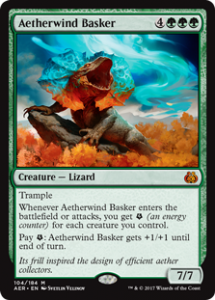
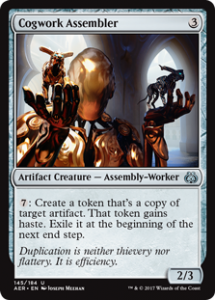
![]()
It’s actually really straightforward to get energy equal to our creature count: Aetherwind Basker does that without any outside help. Its ETB trigger alone gives us another arrow: each trigger adds a 2^^^() to our expression.
But… we’re nowhere near done. You see, if you look closely, everything we’ve done so far can be done at instant speed. That means, we can do all of sections 1 and 2, in between other things resolving. Things like multiple copies of Aetherwind Basker’s ETB. We have a Panharmonicon out, so that means each Aetherwind Basker actually adds TWO copies of 2^^^() to our total.
And if we don’t use our last energy to repeat section 1 a bajillion times, and instead spend all the mana from tapping Itlimoc to repeatedly activate Cogwork Assembler, targeting Panharmonicon, until we have Panharmonicons roughly equal to our Polyraptor count…
That’s right. Each time we play Aetherwind Basker, we actually get X instances of its trigger, where X is roughly our Polyraptor count so far. Each trigger gives us X energy, and in between each trigger we can spend all that energy repeatedly bouncing, replaying, and exerting Hope Tender to get many copies of section 1, which only makes the Polyraptor count that much higher when the next trigger resolves and we get that much energy.
That’s the power of Cogwork Assembler and Panharmonicon. By giving us X copies of each enters-the-battlefield ability, we get to add 2 arrows with just 1 section.
The only problem is, we have no way to replay Aetherwind Basker. It’s not like we can just tap it and bounce it. We need something else…
Input: 1 casting of Aetherwind Basker
Output: Lots and lots of energy
Layer count: 4
Section 4: Life


This section only has two cards: Storm Sculptor and Ipnu Rivulet. As long as we top up on Panharmonicons right before we cast it, we can get X copies of its bounce effect, each of which can be used to bounce Aetherwind Basker, since the ability doesn’t target. When we’re almost out of those, we can use the last one to bounce the Sculptor itself, and we’re ready to go again. That adds another arrow already.
Obviously, we still need a limiting factor to keep us from going infinite. In this case, it’s the blue mana we need to actually play the Sculptor. We have only one way to generate more blue mana in the entire deck: Ipnu Rivulet, which costs us 1 life for the luxury. If you remember, we have 7 life left, so we can add 6 more copies of 2^^^^^() to the front of our count. After that, we can round down what we had so far to 4, or rather, 2^^^^^2, and add an arrow: our count at this point is 2^^^^^^8, Remember that number, that’ll actually be important later.
Input: 1 life
Output: lots of bounces of Aetherwind Basker
Layer count: 5
Section 5: White Mana
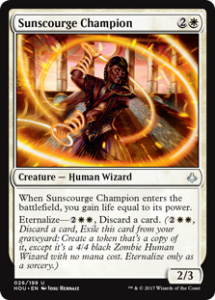
This is another spot where we can double up. Once we’re down to only 1 life left, we top up on Panharmonicons, and play Sunscourge Champion. Before each trigger resolves, we run a single iteration of section 1, but point our Appeal copies at the Champion, giving it X power. The trigger resolves, we gain life equal to our Polyraptor count, and we spend it all on section 4 until all we have left is enough for the next Appeal. All told, this gives us another 2 arrows. If you’re wondering, by the way, this is what the stack would actually look like during this section of the combo, ignoring Forerunner triggers for sanity’s sake:
Polyraptor enrage trigger 1
…
Polyraptor enrage trigger 1 bajillion
(Swarm Intelligence copies of Insidious Will)
Insidious Will
(Swarm Intelligence copies of Select for Inspection)
Aetherwind Basker trigger 1
…
Aetherwind Basker trigger 1 bajillion
Storm Sculptor trigger 1
…
Storm Sculptor trigger 1 bajillion
Sunscourge Champion trigger 1
…
Sunscourge Champion trigger 1 bajillion
Each trigger from a lower batch creates another batch of the trigger above it when it resolves, and each time, the size of that batch, and every batch after it, goes up because of Panharmonicon.
The problem here, is that there’s no obvious limiting factor: if we can play Sunscourge Champion from our hand, then we can just use Storm Sculptor triggers to bounce and replay it, going infinite. We solve this by making it so we CAN’T cast Sunscourge Champion from our hand: that would take white mana, and there isn’t a single way to produce white mana in our deck. We need to find another way to play it.
Input: one playing (?) of Sunscourge Champion
Output: lots and lots of life
Layer count: 7
Section 6: Our opponent’s life total.
![]()

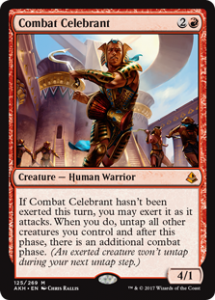

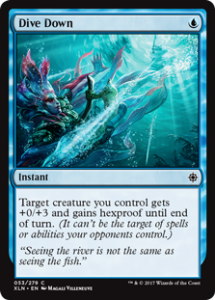
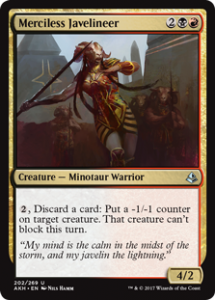
This section gets weird. Fair warning.
Before we get into section 5, when we’re down to just 2 life left, we need to stop and take stock of our situation. We have 2 life, of course, and a massive number of Polyraptors and Panharmonicons, as well as several creatures with size proportional to our Polyraptor count. There are also, if you’ve been keeping count, only 9 cards left in our library: Sunscourge Champion, Hostage Taker, Dive Down, Naturalize, and our five filler cards (mostly Yargles). Our hand is either empty, or has our one Storm Sculptor in it.
The first thing we do is, we go down to 1 life and tap Ipnu Rivulet for U, but instead of playing Storm Sculptor again, we sacrifice one of our other Ipnu Rivulets (we have 3 still, remember) to mill ourselves for 4 cards. This dumps our Dive Down, Naturalize, and two Yargles into our graveyard.
Then we do something I told you we’d never do: we Failure the original Appeal back to hand (so our hand will be Storm Sculptor and Appeal, since we’ll discard Failure immediately for Torrential Gearhulk shenanigans), let our entire stack of triggers resolve, and move to combat. Inconceivable!
We could attack with everything, but we’d kill our opponent, and we don’t want to do that yet. We’d lose out on all the Sunscourch Champion value, for one thing. Instead, we attack with just 3 creatures: Combat Celebrant, Wildfire Eternal, and Gishath, Sun’s Avatar (note: technically, we don’t even have to attack with Wildfire Eternal this time, but we will in the future, so let’s assume we do for now). What’s more, we exert Combat Celebrant, getting another combat phase after this one: that’s quite important.
Our opponent has no blocks, so we connect with Gishath and immediately kill our opponent because we’ve been pumping it with Appeal this whole time.
Wait, no, that’s stupid. Instead, we dedicate an Itlimoc tap to recurring Dive Down, instead of Appeal. We point every single Dive Down copy at Gishath, Combat Celebrant, and Wildfire Eternal, and divide the -1/-1 counters from Merciless Javelineer evenly between them. Their power reduces slightly with each run of this loop, while Dive Down’s toughness boosts saves them from dying to Forerunner Damage. This will obviously cost a lot of mana, but remember, we have mana to spare. If we skip a single Itlimoc tap to do this busy work, it won’t meaningfully impact our total. In fact, we could even spend an energy, or an entire Aetherwind Basker trigger on this, but we don’t have to. These creatures have been pumped by Appeal to have power/toughness roughly equal to our Polyraptor count BEFORE the last appeal loop resolved. Our Polyraptor count is already exponentially higher, so it will only take at most two taps of Itlimoc to get their powers down to 1 or 0.
We also need to know how much to weaken each of our creatures. Combat Celebrant and Wildfire Eternal can both have 0 or negative power, but Gishath needs a full 2 power now, and will need 1 later on. With that done, our opponent has no blocks, and we bash them for 2 damage and trigger Gishath. Gishath reveals our last two combo pieces, Sunscourge Champion and Hostage Taker, and we get our Champion triggers. Piece of cake!
Except that we don’t have Appeal on the stack anymore, and can’t layer it between Champion triggers. That’s where Hostage Taker comes in. We use it to exile Sunscourge Champion, as well as Wildfire Eternal and Combat Celebrant. Hostage Taker, of course, lets us cast each of these cards without caring about color requirements, which is how we replay any of these creatures. It also lets us cast them any time we want, since they all have flash from Cherished Hatchling. That means we can play Combat Celebrant and Wildfire Eternal during the begin combat step of the additional combat phase we got from exerting the Celebrant last time. It also lets us cast Sunscourge Champion a bit later, such as after Wildfire Eternal’s combat trigger resolves and we put Appeal//Authority back onto the stack. After that, all we need to do is loop Run Aground with Torrential Gearhulk/Failure shenanigans, tuck Hostage Taker back on top of our library, and we can reveal it with Gishath on the next combat and do the whole thing over again!
That’s all well and good, but we have a problem: the only way to cast these mardu spells is through Gishath’s damage trigger, which means each time we do it, we’re taking chunks of life off our opponent. They were already at 13 from that time we clocked them with Gishath on turn 5. Our first attack this turn drops them to 11 After that, we only have room for 10 more swings before they’re dead. That alone would get us up to 2^^^^^^^^12 dinosaurs, but to go any higher we need a way to force our opponent to gain life, and in standard, those are few and far between. In fact, there is only one way to do so: Ajani Unyielding’s -2.
Section 7a: Maxing Out our Opponent’s Life Total


There are a /lot/ of problems with this system. For one thing, we need to somehow make our OPPONENT have a creature to target, otherwise we’ll be the ones who gain the life. And for another, we can’t chain it. Once we move to combat for Gishath, we will no longer be able to activate Ajani Unyielding until the postcombat main phase, by which point we won’t be able to attack anymore. It’s mathematically impossible to add more layers beyond this in the current configuration.
We can, at least, solve the first issue, with Baffling End. Yeah, remember that card we played with Rashmi a billion years ago? By destroying it with our Naturalize, we can force our opponent to have a 3/3 dinosaur. Then we hit the token with an Appeal, exile it with Ajani, and boom, our opponent has X life. That in turn means we can clock them with Gishath roughly X times without killing them, giving us that critical final arrow.
Input: one activation of Ajani Unyielding
Output: many combat steps, each one giving us another cast of Sunscorch Champion
Layer count: 8
Section 7: Killing our Opponent
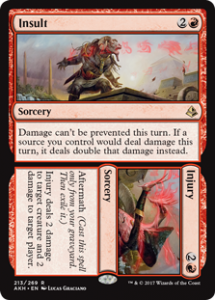
The final moments of our combo are a bit different. After we hit our opponent down to 1 with Gishath, we pull Hostage Taker out and exile our creatures as usual, but when we come back around to combat, we don’t attack with Gishath: just Celebrant and Eternal. We use the same trick to play Sunscourge Champion and gain our life, but deal no damage to our opponent, for obvious reasons. Also, once the last Sunscourge Champion trigger has resolved, we’ve spent all the life playing Storm Sculptor, used up every bounce to replay Aetherwind Basker, we don’t use the energy to repeatedly give Hope Tender haste. Instead, we use it to give haste to all our Polyraptors. Now, technically you can do slightly more damage by running the energy down to 0 and using the last Itlimoc tap to activate Cogwork Assembler targeting itself many times to get huge numbers of hasty robots, but… let’s be honest. I know what you came here for, and it’s not Assembly Workers.
Now, all that’s left is to figure out just how many Polyraptors we have. That’s not a simple problem. The Ajani activation adds a 2^^^^^^^^() to our expression, but we weren’t able to do any Sunscourge Shenanigans beforehand, so the right hand side is the total we had at the end of section 4: 2^^^^^^8. Except we also had to spend a blue mana to mill the Dive Down, so it’s actually 2^^^^^^7. All told, our count is 2^^^^^^^^(2^^^^^^7). That’s pretty ugly, so let’s simplify: If we round 2^^^^^^7 down to 4, then we can express it instead as 2^^^^^^^^2, which would let us collapse the whole thing and make our damage 2^^^^^^^^^3. That is a VAST underestimate of the actual total, but since our Polyraptor count is just a rounding error compared to 2^^^^^^^^^4, it’s the closest we can get.
Section 8: Conclusion
Going into this, I did not expect to get 9 layers of recursion out of the standard cardpool. I expected this to take a day to solve, and that it would wrap up with 2, maybe 3 arrows. It’s a testament to the depth of the game that, even in such a small format, with such constrained options, life finds a way.

Moving forward, there’s a ton of room to improve on this deck, and if you look closely at the list, you’ll see why: there are actually no Dominaria cards in this entire combo! The process of vetting a deck like this for infinite combos, not to mention actually writing up how the deck works, is so time-intensive that if I tried to update this for Dominaria, it would never be finished. That said, standard’s newest set gives us plenty of goodies, and I’m currently vetting another version of the deck that uses some Dominaria additions to get the damage total a little bit higher.
Not by too much.
Just slightly more than Graham’s Number…
See you next time!